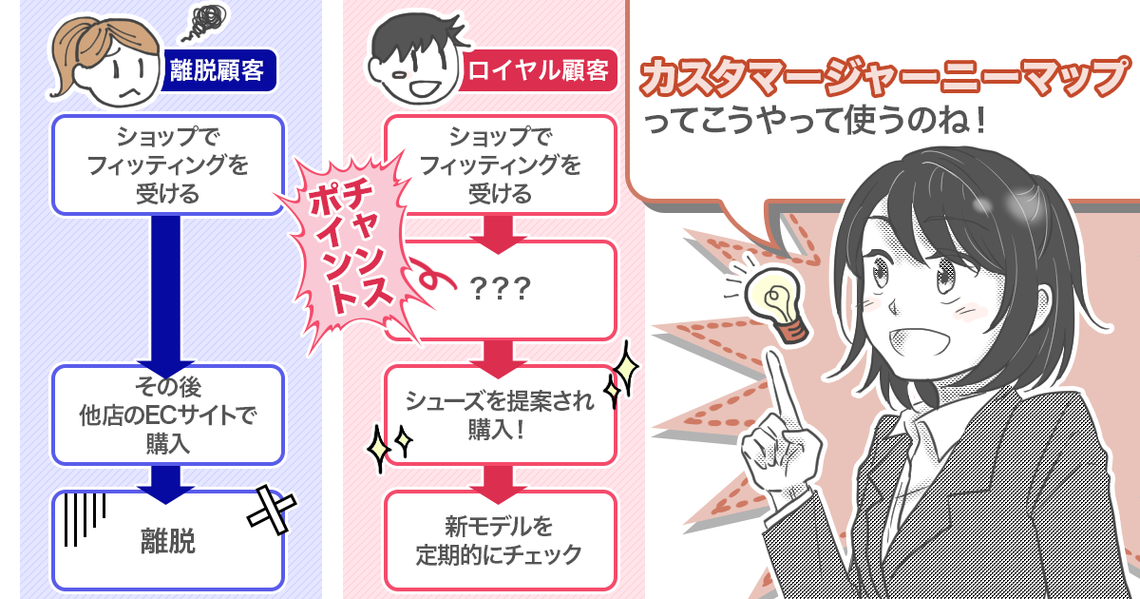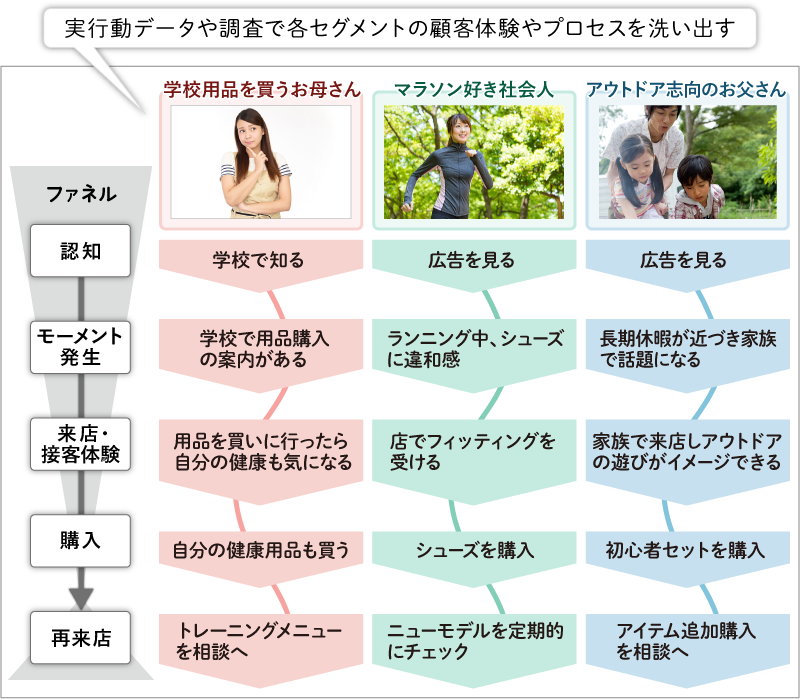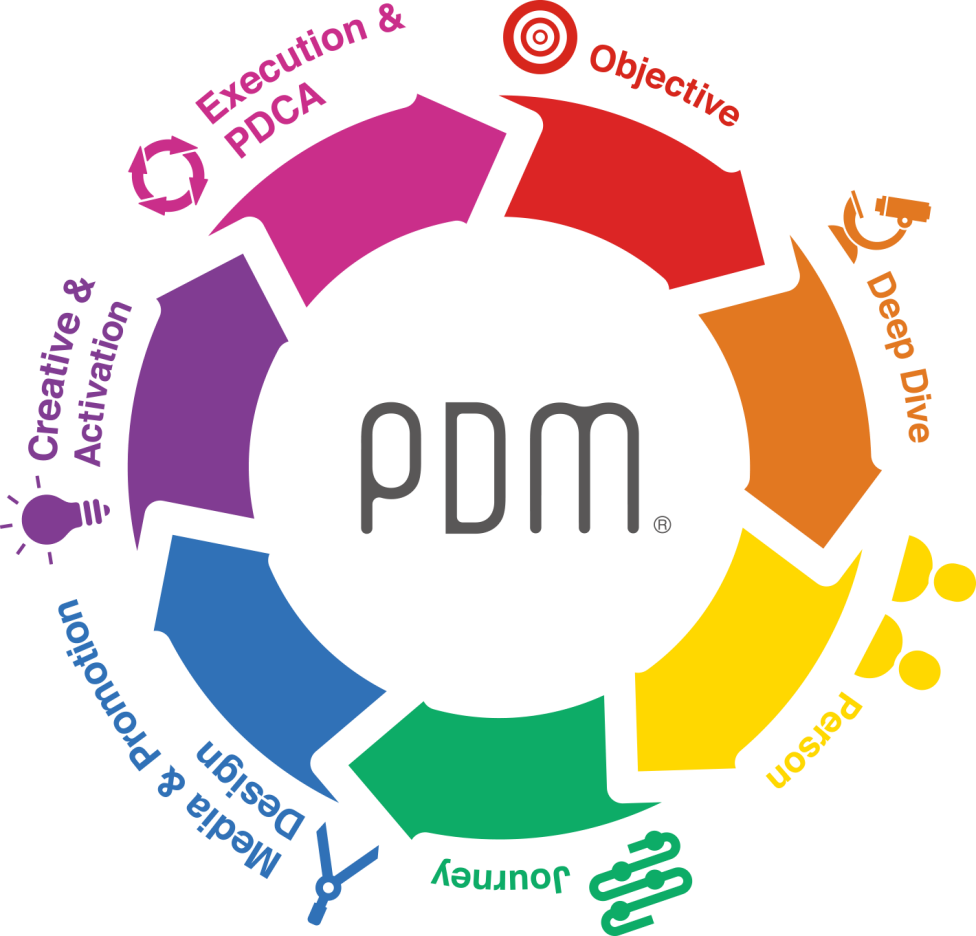
What's troubling Ms. A, who works at a sporting goods store? (Illustration: Saki Kanai)
This series introduces the concept of People-Driven Marketing (PDM). This installment focuses on the Journey—the psychological and behavioral flow leading users to purchase.

There's often a gap between the "ideal customer journey" marketers envision and the actual user behavior and psychology. However, this installment explains that it's precisely within this gap where opportunity points lie.
<Table of Contents>
~Ako's Story: Journey Edition~
Ako, who works at the large sporting goods store "Sports People," researched and analyzed the behavior of both in-store and online customers. She gained a clear understanding, backed by concrete numbers, that customers come in various types ( see Part 2: "People").
For example:
"Working adults in their 30s to 50s who come on weekends looking for hobby marathon shoes"
"Fathers wanting to enjoy outdoor activities with their families and their families"
Ako began developing a customer attraction plan for the store based on this premise.
With this understanding, Ako began planning customer attraction strategies for the store. However, simply knowing "there are various types of customers" risked leading to the same old communication methods—relying on TV commercials and flyers.
"How do I develop tailored customer acquisition strategies for each customer type?"
The contact points needed to encourage visits differ by customer type
I'm Yajima from Dentsu Inc. Second Integrated Solutions Bureau. Having worked primarily on integrated planning in the promotion domain, I'll explain how to create and use customer journey maps in PDM.
The importance of creating a "customer journey map" – which consolidates consumers' "psychology and actions leading to purchase" into a single chronological flow – is often emphasized. However, merely creating the map won't reveal the right marketing strategies for those consumers.
In PDM, which focuses on people based on rich user data, we segment customers into several types or envision a single customer (n=1) to create a customer journey map for each.
By examining each customer experience process chronologically, we visualize potential bottlenecks—opportunity points —within each segment and design the most effective approach.

Example of a customer journey map created based on actual behavioral data and surveys
Here, let's look at two examples of approaches by type.
For marathon-loving office workers who enjoy jogging on weekends
Analysis of store visitor surveys revealed that working professionals who jog on weekends are preoccupied with work during the week. They simply don't have the mental bandwidth to think about running shoes. Even if they see a "Sports People" TV commercial during a marathon broadcast on their day off, it doesn't immediately translate into store visits. For them, the moment they are most interested in their own shoes might be precisely when they are out jogging.
[Approach Example]
What if customers jogging near the store received a message right after finishing their run and taking a break? "How did you feel today? If you're dissatisfied with your run, why not come see the new models at Sports People?"
For fathers who enjoy outdoor activities with their families
A group interview with outdoor-loving fathers revealed the following pattern:
As children grow older, fathers start planning their family's outdoor debut, but families with no outdoor experience aren't quite enthusiastic. Even after seeing Sports People's TV commercials, they seem hesitant to actually visit the store.
[Example Approach]
What if a banner ad appeared for a dad browsing outdoor sites saying: "Sports People offers in-store camping experiences for families wanting to try outdoor activities this summer! Our camping master staff will answer all your family's questions!"
Then, that weekend, while the family is driving to the store, a radio commercial comes on: "Sports People is currently running an in-store camping experience to support close-knit families making their outdoor debut!" Couldn't this nudge Dad and the family to think, "Maybe we should stop by?"
This is why it's crucial to capture insights for each segment, understand " " – what each customer feels and how they act – and build a customer-centric communication plan.
Opportunities lie in the gap between the ideal journey and the actual journey
This time, Ako was struggling with "when, where, and what kind of message to deliver" to each customer. She anticipated that the purpose, trigger, and actions leading up to visiting the sporting goods store would be completely different for each customer.
How should we actually identify measures to get potential customers to visit for the first time or to get existing customers to keep coming back? Is it the advertising message that moves that customer, the in-store experience, or some other factor?
The approach in PDM is as follows:
- Create and compare "ideal" and "actual" customer journey maps for each segment
First, visualize the journey each segment takes over time, based on actual behavior data and surveys like those seen in the previous article.
Then, highlight the gap between the company's envisioned "ideal journey of a loyal customer" and the "actual journey of a churned customer."
Within this gap—the bottleneck causing customer churn—we discover "opportunity points" for conversion acquisition.
For example, Ms. A's "ideal" might be the purchasing behavior of a loyal customer who visits regularly without going to other stores. On the other hand, the "reality" could be the purchasing behavior of a switching customer who uses other stores as well.
Using "working adults who love marathons" as an example, we compared the ideal and actual customer journeys side-by-side, focusing on the differences (gaps) in awareness and behavior.


By comparing customer experience processes as sequential maps, we visualize "where drop-offs occur."
By identifying opportunity points for each segment in this way , it becomes possible to create communication scenarios centered around these opportunity points.
This scenario is the "customer-centric reference point" that should be shared with all stakeholders involved in brand experience and communication design. Whether it's media planning or creative work, it should be developed in alignment with this "scenario for each segment."
PDM further visualizes whether customers actually followed the scenario, enabling the PDCA cycle. We'll cover that in another session.
While A-san conducted her own analysis this time, leveraging the extensive online and offline touchpoints provided by Dentsu Inc. and its partner companies enables the creation of a more precise customer journey map. Interested parties are welcome to consult with us.
Ako Discovers How to Identify Opportunity Points
With help from her store manager and staff, A-ko created "Customer Journey Maps by Customer Type" and compared the ideal journey with the actual one. This revealed how each customer type typically approaches sports and what they seek when visiting the store.
- For marathon-loving working professionals
We discovered that many customers in this category wanted the store to "provide appropriate advice on whether shoes they researched online would fit their feet."
Additionally, when we spoke with loyal customers who have been visiting monthly recently, several mentioned, "I participated in a store-hosted running event once and became familiar with the staff. I feel a sense of trust."
"In other words, advice from staff and participation in events might be key opportunities."
Ako devised a plan for weekends when working professionals visit: a running event led by store staff and an on-site corner for comparing and trying on new models. Continuing such initiatives might shift the journey of "working professionals who love marathons," transforming their reality into their ideal.
Ako then began developing communication strategies, including advertising, centered around the "opportunity points" she had identified. (To be continued)










